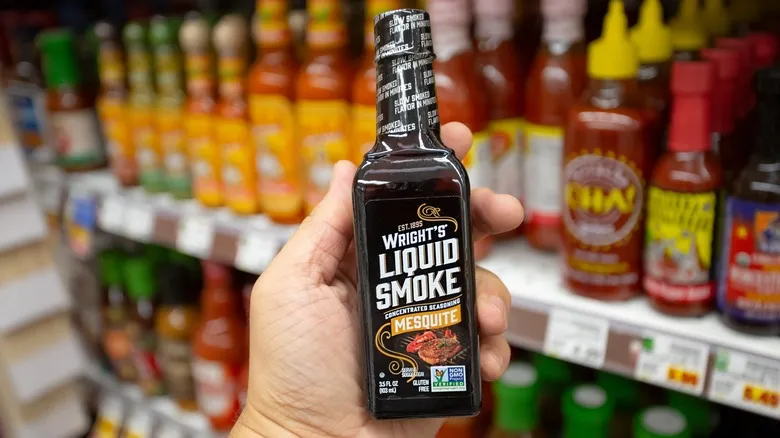What is liquid smoke?

Certain aspects of life are straightforward, and liquid smoke is one of them. Essentially, it's smoke-infused water that can enhance both savory and sweet recipes. Some varieties of liquid smoke include extra ingredients like vinegar or caramel coloring, and they typically have added salt. Many products found in grocery stores, from hot dogs to beef jerky, incorporate liquid smoke. Recently, it has also become a common item in the kitchens of home cooks.
Liquid smoke is favored by many chefs because it provides an effortless way to infuse that smoky barbecue taste without the need to burn wood chips or charcoal. This significantly reduces both preparation time and costs for dishes intended to have that freshly grilled flavor. Even if you have the time to fire up the grill, you might prefer to avoid the hassle of charcoal or mesquite chips, making liquid smoke an ideal alternative.
When was it created?

Liquid smoke has a long history, dating back to 1895 when pharmacist Ernest H. Wright, the creator of Wright's Liquid Smoke, discovered that smoke condenses upon contact with cold air. This insight inspired him to collect and refine smoke products, which he then marketed to farmers for use in their meat products. Thus, a tasty and convenient kitchen alternative was created.
In its initial use, liquid smoke also served as a preservative. Research published in the journal Frontiers in Microbiology indicates that it can extend the shelf life of products containing it by up to three weeks, depending on its concentration. However, it is not the most effective preservative, leading early adopters to abandon it for that purpose. Today, liquid smoke is primarily utilized as a flavoring agent, a role in which it truly excels.
Liquid smoke ingredients and production
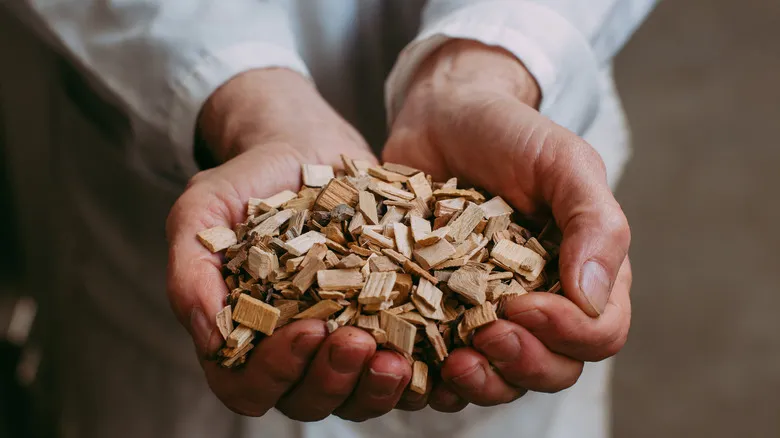
Given that this seasoning features the word "smoke" in its name, it’s no surprise that liquid smoke is produced by burning wood and capturing the resulting essence. Typically, the wood is burned at high temperatures to create smoldering rather than open flames, allowing the smoke to be released gradually, similar to a smokehouse. In a process reminiscent of how smoke condenses on meat, the vapors from the smoke condense on cooler surfaces within the production equipment, where they are quickly cooled and purified. During this filtration process, undesirable and unpleasant components like soot and ash are eliminated.
Similar to the barbecue sauce that often accompanies grilled meats, liquid smoke comes in various flavors and uses based on its ingredients. However, unlike the vast array of barbecue sauces available in the U.S., there is limited variation in a formula that essentially consists of purified and condensed gas. Nevertheless, the flavor of liquid smoke can differ depending on the type of wood used in the smoking process, with hickory, mesquite, applewood, and pecan being popular options.
Liquid smoke: Part of a vegan diet?

Great news for those who follow a plant-based diet: liquid smoke is entirely vegan! Made from wood chips and water, along with a few seasonings, nearly all varieties of liquid smoke are plant-based. To ensure you're getting a completely plant-based ingredient, look for products that contain only water and smoke, and are labeled "free from other additives."
Many vegans often feel left out of traditional barbecue because they avoid meat. The most popular alternative, barbecued or smoked tofu, is tasty and versatile in various dishes (think tofu scrambles and sandwiches), but why limit yourself to just a few ingredients? With liquid smoke, you can enhance any vegan dish, from dips and beans to vegetables and plant-based meats. Plus, depending on the type of wood used in the smoking process, you can enjoy a variety of flavors in your vegan creations.
How to choose liquid smoke at the store

Selecting liquid smoke is not a challenging endeavor. However, the availability of options can vary based on your location. For example, the United States offers a wider selection compared to the European Union. In the U.S., you can find flavors such as hickory, mesquite, and applewood, while food regulations in other regions may limit production. Fortunately for BBQ sauce enthusiasts in America, you should have no trouble finding it, often located near the barbecue sauces.
Manufacturers may also incorporate additional ingredients to enhance the flavor profile, such as apple and maple flavoring in the applewood variety. To find out what’s in a bottle, the best approach is to examine the ingredient label. If you’re shopping in-store, this is straightforward. When shopping online, simply browse through the images until you locate one that lists the ingredients. This label will provide details not only about the components used to create the smoke but also the nutritional information, which will be elaborated on further below.
How do cooks use liquid smoke?

The primary purpose of using liquid smoke is to compensate for the absence of grilling or smoking, allowing you to achieve that desirable smoky flavor without the effort of traditional methods. For example, you can prepare kalua pork, one of my favorite Instant Pot recipes, without the need to tend to a firepit or an entire pig for hours. It’s a simple way to infuse smoky flavor into brines, marinades, or barbecue sauces in just one step.
Liquid smoke can also enhance a wide variety of meat products, including fish and beef jerky. But it’s not limited to meat; anything you might grill can benefit from its smoky essence, such as vegetable skewers. Even extra-firm grilled tofu, which has a texture reminiscent of steak, can be elevated with a touch of liquid smoke.
However, it’s important to be aware of the potential downsides of liquid smoke. It is sometimes used in restaurants to mask subpar barbecue. Additionally, it can overshadow the delicious flavors of rubs or the natural smokiness of the meat, which is why you should be cautious with pre-sauced dishes at barbecue joints and add sauce sparingly after tasting. This isn’t to suggest that liquid smoke is inherently bad; rather, if you’re paying for authentic barbecue, you deserve to experience the real deal.
Other ways to use liquid smoke in the kitchen
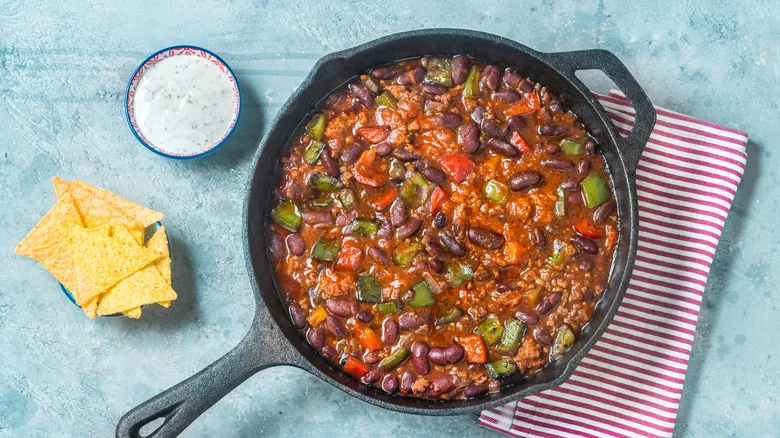
The most apparent application of liquid smoke is to infuse your meat dishes with that delicious grilled or smokehouse taste. However, its uses extend far beyond just marinades, brines, and sauces.
For example, it can elevate canned chili to new heights and serves as a fantastic addition for making gas-grilled asparagus that tastes as if it were cooked over charcoal. If you're aiming to replicate McDonald's iconic breakfast sauce, you'll find that liquid smoke is the secret ingredient, combined with mayo, lemon juice, cheddar cheese, buttermilk powder, herbs, spices, and autolyzed yeast.
Liquid smoke can also enhance everyday ingredients. For instance, you can amp up store-bought guacamole by grilling an avocado and mixing it in with a splash of liquid smoke. Dishes like mac and cheese, shrimp cocktail, and boiled peanuts can all gain a delightful smokehouse flavor. It's also an essential component in delicious baked beans, paired with ketchup, molasses, spices, and bacon. But if you prefer a plant-based diet, you can easily omit the bacon without sacrificing flavor, thanks to the liquid smoke. Hooray!
Liquid smoke for cocktail hour and dessert

There's no reason to limit liquid smoke to just lunch and dinner or savory dishes. Surprisingly, it can also enhance cocktails and desserts! It pairs beautifully with a variety of traditionally sweet flavors, which makes sense considering our collective fondness for bacon donuts. If you're looking to add a playful twist to your dessert time, consider mixing liquid smoke into caramel pecan sauce, chocolate chip cookies, or bourbon chocolate fudge, among other treats.
The cocktail possibilities are even more exciting, as smoky notes complement whiskey, mezcal, and non-alcoholic ingredients like tomato juice, simple syrup, and lemon. Drinks like Tequila Sours, a delightful orange-maple Old Fashioned, and Manhattan cocktails all benefit from a touch of smokiness. For those eager to experiment, try creating smoked ice cubes by replacing regular ice with liquid smoke!
Substitutes for liquid smoke
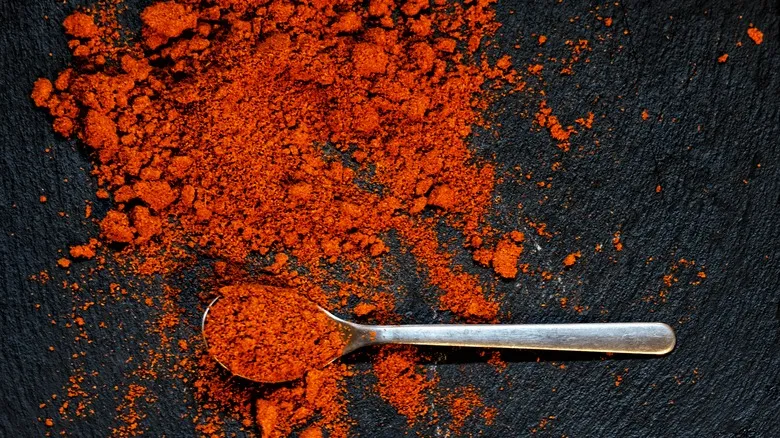
If you don't have liquid smoke on hand, your best option is to use another smoked ingredient like chipotle or smoked paprika. Both of these are infused with a smoky flavor during their production, providing a similar aroma and taste. Keep in mind that since they are derived from peppers, they can be quite spicy, particularly chipotle. Ensure your recipe can handle the heat; if not, opt for mild smoked paprika, which is readily available in stores. If those options aren't accessible, consider using smoked salt or smoked tea.
Another alternative is to incorporate smoked meats, smoked fish, or barbecue sauce into your dish. This can be a great way to add a smoky flavor and enhance the complexity of your recipe. For example, if you lack smoked clams for your clam chowder, you can use regular clams and add some smoked salmon for an extra seafood boost. If your dish includes cheese, swapping in smoked gouda or Swiss can also work well.
Of course, you can also choose to smoke or grill your ingredients, provided they are meats, seafood, or vegetables that can maintain their shape. This method will give you that authentic barbecued flavor. However, at this stage, it’s advisable to follow a different recipe specifically designed for the cooking method you plan to use. This approach will yield the best results and help you avoid any unexpected issues that may arise from substituting ingredients in a recipe.
Overusing liquid smoke

The primary issue with liquid smoke is the tendency to overuse it. Keep in mind that liquid smoke is produced through an actual burning process, so adding too much can result in an unpleasant ashy and bitter flavor reminiscent of smoldering wood. Some even describe it as having a chemical taste, which, in my opinion, is even less appealing than "ashy."
Therefore, it's important to use it sparingly. A small amount of smoke can have a significant impact. Your recipe should specify the exact quantity to use, so there's really no reason to overdo it. Be particularly careful when incorporating it into desserts, as it can easily overpower sweet flavors more quickly than savory ones, potentially ruining a caramel sauce or bourbon ball.
If you find that your dish has an overwhelming smoked flavor, there are ways to remedy the situation. For example, you can mix your meat with a sauce that has sweet and spicy elements to help balance the flavors and mask the bitterness. In other recipes, consider adding unlisted ingredients to neutralize the taste. For desserts, adding cream might help, while a splash of balsamic vinegar could work for vegetables. It may take some trial and error to adjust the seasoning, just like with any other cooking challenge, so don’t be too hard on yourself. Sometimes you have to break a few eggs to make an omelet.
Can you make your own liquid smoke?

Certainly! Here’s a rewritten version of your text:
Absolutely, you can create your own liquid smoke. However, doing so requires a significant amount of equipment and possibly some engineering expertise. On a serious note, if you enjoy inventing and have the time to construct elaborate culinary contraptions, this could be a fun project for you.
In essence, producing your own liquid smoke involves trapping flavor compounds in a liquid form. Sometimes this process is straightforward, like making vanilla extract by soaking beans in alcohol and allowing the flavors to develop. Other methods, such as infusing garlic in olive oil, also require heat. Unfortunately, making liquid smoke is considerably more complex than either of these techniques.
You need to carefully heat wood chips to a temperature high enough to burn the lignin, which occurs at 752 degrees Fahrenheit. After that, you must pass the smoke through water in an oxygen-free environment to capture the water-soluble flavor compounds while discarding the rest. As you can imagine, this process is highly technical, but there are tutorials available online if you're determined to give it a try.
Is liquid smoke safe to consume?
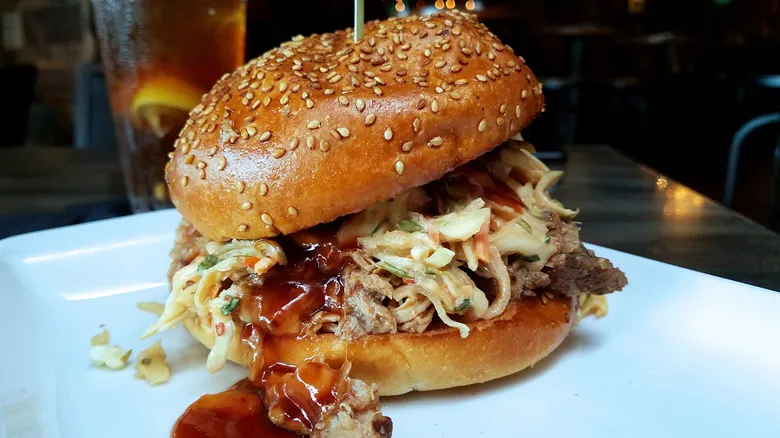
Spoiler alert: liquid smoke is generally safe. While smoke is often linked to carcinogens, which can make smoked meats a bit concerning, liquid smoke doesn't carry the same risks. Research on bacteria has indicated that liquid smoke flavorings are not mutagenic, meaning they don't alter DNA in a way that could lead to cancer. In fact, many common foods, like smoked lox, often exceed the recommended daily limits for carcinogenic compounds, yet we consume them without hesitation.
The positive aspect of liquid smoke flavorings is that the carcinogens found in smoke are fat-soluble, not water-soluble, and since liquid smoke is water-based, it doesn't contain those harmful compounds. This allows us to enjoy the flavor without the cancer risk. Although it does have trace amounts of carcinogenic compounds, these levels are well below the safe daily limit.
A word of caution for those who like to make their own: avoid soaking smoked wood chips in water to create a budget version of "liquid smoke." This method is entirely different, won't yield the same results, and could introduce a significant amount of carcinogens into your diet.
Storing liquid smoke to last

Like many other seasonings, air and light can diminish the potency of liquid smoke, leading to a loss of flavor and possibly introducing off-tastes to your mixture. Therefore, it's best to store it in a tightly sealed container in a cool, dark environment. When stored properly, liquid smoke can remain good for years after opening, although using it within one to two years is recommended for optimal freshness.
Some brands may advertise a shelf life of up to four years, so it's wise to refer to the specific brand's guidelines. Since liquid smoke contains very few ingredients that can spoil or cause illness, it is generally safe to use beyond the recommended time frame, provided it doesn't have an unusual odor. Additionally, its low pH level (usually between 1.5 and 5.5) helps preserve its quality, along with its inherent antimicrobial properties.
Refrigeration is not required after opening, as liquid smoke can remain stable at room temperature if kept in a well-sealed bottle. However, refrigerating it may further extend its shelf life, as long as it is stored properly to avoid any strange flavors from poor sealing. Given the long-lasting nature of liquid smoke, refrigeration is typically unnecessary unless you live in a very hot climate with inadequate ventilation.
Nutritional information

Certain brands of liquid smoke, like Colgin's, are calorie-free and fat-free. The same applies to Wright's, another well-known brand. However, other manufacturers may include different ingredients, and the presence of sugars or other caloric components in their sauces varies based on their specific recipes. With the rise of small-batch, artisanal, and family-owned brands in the market today, it's difficult to make a definitive statement.
Additionally, nutritional databases indicate that some formulas do contain calories, albeit in small amounts—approximately five calories per teaspoon. Since it's uncommon to use more than that in an entire recipe, this is considered negligible. In fact, using an excessive amount of liquid smoke is likely to result in an unpleasant experience that most home cooks will avoid repeating, so there's little need to worry about overusing it. Most liquid smoke products are also naturally gluten- and dairy-free (hence their vegan label), making them suitable for individuals with dietary restrictions due to allergies.
Recommended
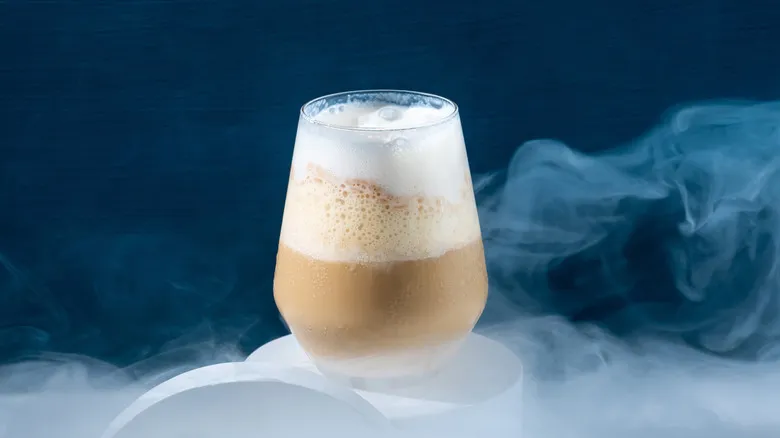
Give Your Iced Coffee An Elegant Upgrade By Smoking It (Yes, Seriously)
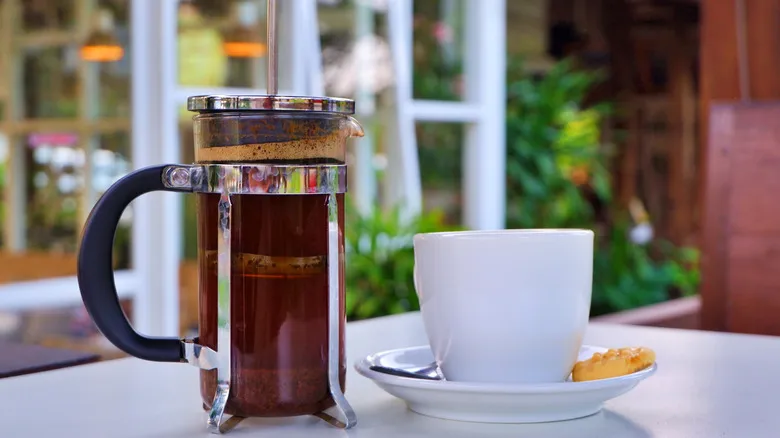
The Simplest Way Your French Press Coffee Machine Can Help Make Dinner
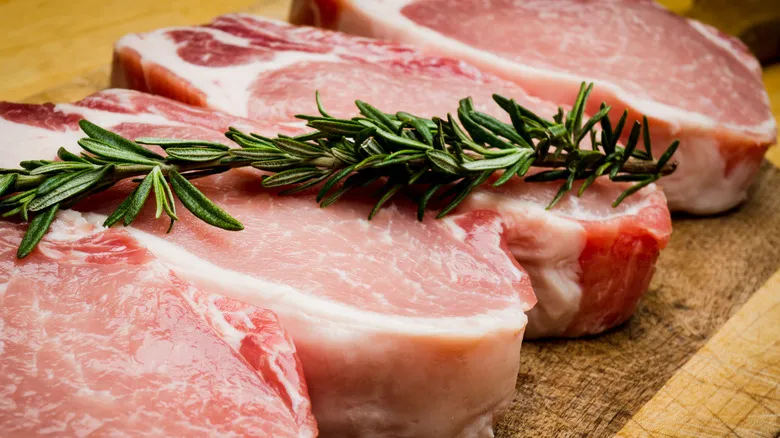
All Your Burning Questions About Grilling Pork Chops, Answered
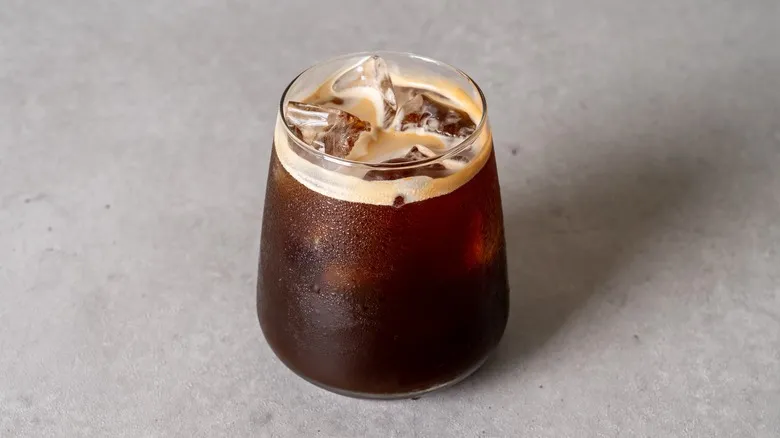
The Fizzy Addition That Transforms Your Iced Coffee
Next up

